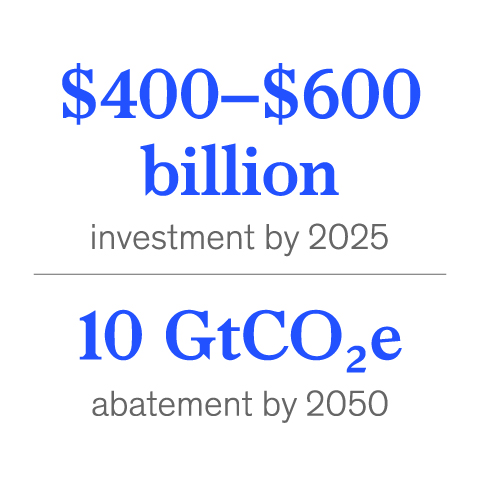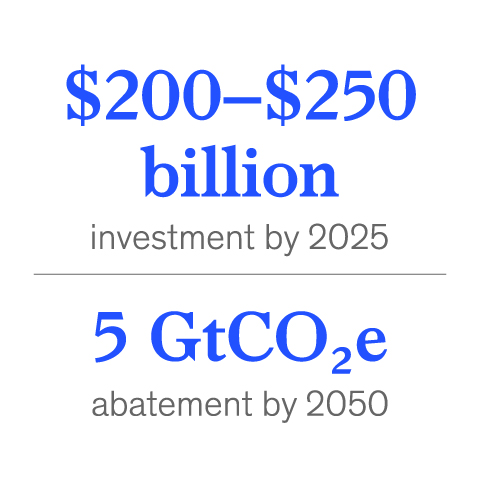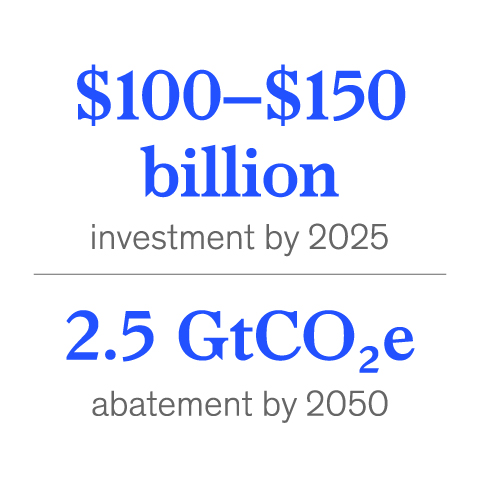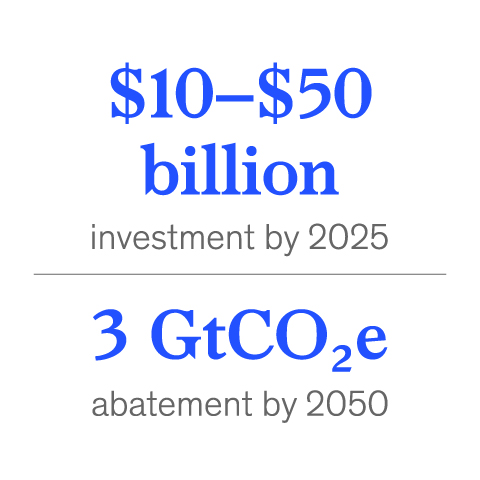New technologies represent a critical part of the world’s decarbonization tool kit—and the world does not yet have all the technologies that it would need to solve the net-zero equation by balancing sources and sinks of greenhouse-gas (GHG) emissions. The good news: McKinsey research on Europe’s net-zero pathway suggests that climate technologies that are already mature could, if deployed widely, deliver about 60 percent of the emissions abatement that will be needed to stabilize the climate by 2050. The challenge is that further abatement must come from climate technologies that aren’t quite ready, including 25 to 30 percent from technologies that are demonstrated but not yet mature and another 10 to 15 percent from those still in R&D.
This need for innovation makes the pace of decarbonization difficult to predict. When, for example, will clean hydrogen cost $1 per kilogram: in 2025 or 2050? The answer will affect the speed at which industries from aviation to steel can decarbonize. Similarly, unless manufacturers of utility-scale batteries can make them at low cost, power producers will have to keep running fossil fleets to cope with the intermittency of renewables. Uncertainty about the availability of financing for innovation limits capital formation and slows scale-up. Integrating most climate technologies into existing infrastructure, hardware, software, and operational systems will be complicated, too.
Yet there are reasons to be optimistic. Recent history suggests that researchers and businesses can deliver the necessary advances and cost reductions (see sidebar, “Charting cost reductions for climate technologies”). Over the past decade, the cost of some renewable-energy projects came down by almost 90 percent, as did the costs of electric-vehicle (EV) batteries, LED lighting, and other energy-efficient hardware. Capital is increasingly plentiful, evidenced by the revaluation of cleantech stocks that began in June 2020, and by the growth in investments earmarked for sustainability and environmental, social, and corporate governance (ESG) objectives. Governments are lending strong fiscal support to low-carbon innovation. Pledges from big companies not only to cut emissions but also to decarbonize operations and product lines—to buy only renewable fuel or make only EVs—give confidence to entrepreneurs and their backers. Talk of regulatory mandates lends weight to these demand signals.
And, again, the need for climate technology is vast—which creates large potential markets and investment opportunities. Our estimates suggest that next-generation technologies could attract $1.5 trillion to $2 trillion of capital investment per year by 2025.1 To enter these markets and navigate them successfully, established companies, start-ups, and investors will need a nuanced and ever-evolving understanding of technical advances, customer demands and commitments, and policy environments. In this article, we lay out five areas with considerable promise, along with potential obstacles along the path to scale (exhibit):
- electrifying transportation, buildings, and industry
- launching the next green revolution in agriculture
- remaking the power grid to supply clean electricity.
- delivering on the promise of hydrogen
- expanding carbon capture, use, and storage

Electrifying transportation, buildings, and industry
Coal, oil, and gas have been the main fuels used to power buildings, industrial machines, and vehicles since the early 20th century. Getting to net-zero emissions will require electrifying most equipment and processes that now run on hydrocarbons and converting the electric-power system to renewable sources (see the next section). Many forms of electric gear, from EV batteries to heat pumps to industrial furnaces, remain expensive. Further innovation will be needed to reduce costs and increase uptake of the electric hardware that will drive a net-zero society.
Better EV batteries. Electrifying transportation requires cutting the cost of batteries, which can account for as much as half the cost of an EV. However, the lithium-ion batteries that are most common in EVs may never fall below the critical threshold of $100 per kilowatt-hour. To boost energy density and cut costs, battery chemistry will have to improve. Companies are working on anodes with high silicon content, which represent the next frontier. Beyond that, innovations in solid-state, gel, and foam electrolytes would turn ultra-high-capacity lithium metal anodes from a concept into a reality, and one that is safer than today’s battery technology.
Battery-control software. Hardware improvements aren’t the only route to better batteries. Software control systems can also help, and even make up for shortfalls in chemistry. They can shorten charging times: imagine recharging an EV with a 300-mile range in ten minutes or less, instead of one hour at a supercharger or overnight on most home systems. They can prolong battery lives enough to match the life of the vehicle. And they could give EVs added pickup or hauling or towing capacity.

Efficient building systems. Buildings account for about 7 percent of global CO2 emissions. Cutting those emissions would require making buildings more energy efficient with technologies such as LED lighting, high-efficiency HVAC, and energy controls. But efficiency alone isn’t enough. Buildings, like vehicles, have to go electric. Using heat pumps to keep buildings warm, instead of traditional boilers and furnaces, could cut global CO2 emissions by 3 gigatons per year if implemented worldwide. Today’s models are 2.2 to 4.5 times more efficient than gas furnaces, and recent advances, such as multiple or variable-speed compressors, let heat pumps work in cold conditions that once caused problems. Heat pumps do remain expensive, so cost declines, especially for air-source heat pumps, would likely have to happen before they are used widely.2 In addition, energy-reactive windows and those with embedded solar cells could enable buildings to generate all the power they need.
Industrial electrification. As prices of renewable electricity and electric equipment drop, industrial companies could lower costs and emissions by electrifying their operations. The opportunity appears large. Industrial sectors such as cement, chemicals, and steel together consume more energy than other sectors (such as electric power and transportation), and only 20 percent of that energy is electricity. What’s more, electrical equipment is less costly and more reliable for many industrial applications, though not all. Electric furnaces, for example, can make heat up to 350°C, but not the high heat of up to 1,000°C that many industrial processes need. Innovation will be needed to address these gaps. There is also the question of how to finance industrial electrification. Replacing long-lived equipment early can mean writing it off, and industrial products tend to have tight profit margins, which can discourage companies from making big capital outlays. New financial mechanisms could help companies cover the up-front cost of electric equipment even with the long payback period.
Launching the next green revolution in agriculture
Agriculture accounts for about 20 percent of global GHG emissions. The most significant GHG from agriculture is methane, which has many times the warming power of CO2. Reducing methane emissions from agriculture (and other sources) would require major changes to how society farms, eats, manages supplies and waste, and stewards cropland and forests. Many of the changes would be enabled by climate technologies, some of which are relatively mature while others need further development.
Bringing these technologies to the more than two billion people who work in agriculture will be one of the most difficult tasks on any path to 1.5°C of warming, requiring cost reductions, assistance programs, and infrastructure (such as distributed clean energy). These developments would amount to a new green revolution, one with the potential to surpass the gains that were realized as efficient farming practices were applied widely in the 1960s. These are some of the technologies that could decarbonize agriculture.
Zero-emissions farm equipment. The largest amount of on-farm emissions abatement could be achieved by shifting from traditional fossil-fuel equipment and machinery—such as tractors, harvesters, and dryers—to their zero-emissions counterparts. The economic potential is significant: deployment of zero-emissions equipment could produce cost savings of $229 per ton of carbon dioxide equivalent (tCO2e). Nevertheless, uptake of zero-emissions farm equipment and machinery is far behind that of EVs; most varieties are still in the proof-of-concept or prototype phases. Cost reductions and supportive financing would accelerate adoption.

Meat alternatives. Between one-quarter and one-third of global methane emissions are estimated to come from the digestive processes of cattle, sheep, and other ruminant animals. Those emissions will be difficult to abate unless consumers opt to change their diets. But some of the meat and dairy that people now eat could be healthfully, and cost-effectively, replaced with protein from crops such as legumes and pulses. This may require more land and different planting practices but could also reduce deforestation related to the clearing of land for pasture. Lab technology also points toward meat substitutes. Some are plant-based: Beyond Meat and Impossible Foods are two of the leading names in the field. Cultivated meats—those grown in bioreactors from animal cells—are also advancing. McKinsey research suggests that this could become a $25 billion global industry by 2030.
Methane inhibitors. Companies are developing feed supplements and substitutes that inhibit methane production by altering an animal’s digestive processes. Trials have shown that these can reduce methane production by 30 to 50 percent. Propionate precursors—a class of free acids or salts, such as sodium acrylate or sodium fumarate—have been shown to inhibit methane emissions from cattle without affecting animals’ growth, and one of these has entered the EU approval process.
Anaerobic manure processing. Manure from cattle and hogs can release significant amounts of methane. Processing manure in anaerobic digesters can cut emissions and also generate biogas, a renewable form of natural gas that can be used on farms, sold to the grid, or fed into production of “gold hydrogen.” Such digesters are now used, though not widely, to control odor and pathogens. But companies are partnering with agriculture and landfill sites to produce biogas for various purposes, such as making compressed natural gas, which counts as a transport fuel under California’s low-carbon fuel standard.
Bioengineering. Bioengineering advances agricultural productivity and carbon sequestration and thereby lowers the sector’s emissions. Promising technologies include editing of plant genes to promote disease resistance and manage the soil microbiome.
Remaking the power grid to deliver clean electricity
Almost everywhere, power grids are old, inefficient, unreliable—and carbon-intensive. They are nowhere near ready to handle the doubling of electricity demand that could take place by 2050 as electrification happens, let alone prevent a commensurate increase in carbon emissions. Modernizing and decarbonizing the grid involves three main tasks. One is speeding the installation of renewable-generation capacity; to achieve a 1.5°C pathway, we estimate that the global installation rate would need to increase from 3 gigawatts per week to 15 to 18 gigawatts. Another task is adding energy-storage capacity to manage the intermittency of solar and wind. Last is upgrading the transmission and distribution network to accommodate more front-of-the-meter and behind-the-meter assets.
Few utilities are known as risk takers. For the most part, they are set up—and required by regulators—to deploy proven, mature technologies. These tendencies present limitations. But if innovators and grid operators work together (for example, on accelerating the scale-up of long-duration storage) and regulators send helpful signals (for example, by defining mechanisms to reward providers of battery storage and other services that help deal with intermittency), then the following technologies could help create a zero-carbon grid.
Long-duration storage. Even with falling solar and wind costs, as well as cheaper lithium-ion batteries, the intermittency of renewables makes these technologies impractical as the sole source of grid power. A solution is long-duration energy storage, which can store enough power to supply a network for two weeks or more (a typical period of limited renewable generation in many markets). In comparison, lithium-ion batteries can provide backup power cost-effectively for only four hours. At a levelized cost3 of less than $20 per kilowatt-hour, long-duration storage would make 100 percent renewable systems cost-competitive in US states with ample wind and solar resources. Storage costs of $150 per kilowatt-hour would allow very high wind and solar penetration, provided that power systems also include strong demand-side management, backup gas turbines, or more integration of regional transmission networks.4 Multiple storage technologies are emerging, including power-to-gas, flow batteries, and compressed or liquefied air. Big and small companies are active in this market, and start-ups are pioneering more advanced options such as mechanical systems and modular pumped hydro.

Advanced controls. Today, grid utilization tends to average below 50 percent because the grid is built for times of peak demand and its performance worsens in extreme heat or cold. As more renewables and storage systems are deployed at the grid edge, in homes and commercial sites, they will make power grids more complicated to operate. Resilience, flexibility, safety, and efficiency can be improved with technologies such as solid-state transformers, advanced flexible AC controllers that allow more controlled grid flow, and high-voltage DC technologies for data centers.
Software and communications. Traditional electrical grids use idling power plants to maintain grid balance. These so-called spinning reserves are expensive to run but can respond quickly when demand fluctuates. Modern electric grids would rely on ultrafast communications to maintain grid balance by managing every device on the network. Software-defined inertial substitution (to maintain grid balance when there are fewer spinning reserves), advanced “volt-var” management (to maintain proper voltage over long transmission lines or in highly congested urban markets), and network-wide instrumentation for condition monitoring and fault isolation would help utilities spot issues and prevent interruptions. Distributed energy-management software can coordinate all these elements. Digitized grids will require better cybersecurity protection.
Vehicle-to-grid integration. As more drivers switch to EVs, the big batteries in their driveways and garages could be hooked up to the grid to provide energy-storage capacity. One million typical EVs would offer about 75 gigawatts of storage, hundreds of times more than today’s single biggest utility-scale storage facility provides. Residential backup batteries add more. Accomplishing this integration requires technologies such as inverters that connect rooftop solar, wall batteries, EV batteries, and the grid, as well as fast chargers that buffer the grid from demand spikes while keeping EV batteries full.
Building-to-grid integration. As buildings’ energy controls improve, the buildings can be dispatched to the grid—that is, used to supply power—in ways that improve system performance. Buildings with energy storage or cogeneration could feed power onto the grid when called for, producing income for their owners. And if a utility could reduce power demand slightly in a central business district by signaling buildings to turn down lights, it could cope with demand spikes less expensively than by turning on a gas peaker plant.
Next-generation nuclear. Nuclear energy has an uneven history: from the 1950s’ promise of “too cheap to meter” energy to construction-cost overruns in the 1970s to post-Fukushima fears. Now, the push to decarbonize power has lent new appeal to nuclear generation, which is emissions-free. Emerging technologies include the sodium-cooled, molten salt, and helium-cooled reactors known as “GenIV”; small, sealed, modular, factory-built reactors; and fusion energy, an area where new start-ups are pushing costs down and timelines forward to prototype devices in the mid-2020s, ahead of government-backed research programs.
High-efficiency materials. Scientific advances could produce materials for a wide range of clean-energy applications. Solar cells made with perovskites, a special type of crystal, could outperform regular silicon solar cells—and cost less to make. Graphene, a single-atom-thick sheet of carbon, could revolutionize batteries (by enhancing conductivity and storage capacity), solar cells (by offering superior conductivity contacts with lower light blockage), and high-efficiency transmission lines to carry power from remote but productive renewable-generation sites.
Scaling up the use of hydrogen
Hydrogen could play a significant role in decarbonization, as a clean-energy carrier or fuel ingredient with many applications. High-energy density and zero-carbon combustion make hydrogen well suited to address the 30 percent of GHG emissions—across sectors as diverse as aviation and shipping, industry, buildings, and road transport—that would be hard to abate with electricity alone. Hydrogen could ultimately satisfy 15 to 20 percent of energy demand.
After a push in the early 2000s, innovation in hydrogen technologies stalled. Now it has new momentum. The Hydrogen Council identified 131 large-scale hydrogen projects announced between February and July 2021, bringing the total to more than 350. Direct investment in these projects, which would produce 11 million tons of hydrogen annually, is expected to top $130 billion.5
Hydrogen has a long way to go to fulfill its potential. An entire infrastructure of pipes and storage facilities would have to be built, at great expense. Europe is responding with a plan, the EU Hydrogen Backbone,6 to link low-cost supply centers with European demand centers. Other technologies integral to the hydrogen economy include the following.

Low-cost production. If hydrogen could be made for less than $2 per kilogram in the European Union or $1 per kilogram in parts of the United States by 2030, major end uses would become economically viable. One production process is the electrolysis of water, whereby electricity is used to split water molecules into hydrogen and oxygen atoms. If electrolyzers run on renewable electricity, the resulting “green hydrogen” is carbon-free. (By comparison, “blue” hydrogen, made from natural gas, is carbon-intensive.) Estimates suggest that electrolyzer costs could fall 60 to 80 percent over the next decade.7
Road-transport fuel. Hydrogen’s higher energy density makes hydrogen fuel-cell electric vehicles (FCEVs) suitable for long-haul or heavy road transport. For FCEVs to be adopted widely, they would need to become less expensive, and fueling stations would need to be built.
Ammonia production. This is one of the most promising near-term uses for low-carbon hydrogen. Green ammonia, made with green hydrogen, should be the first variety to match the cost of conventional ammonia production. Hydrogen is also relatively straightforward to integrate in ammonia production, so less supporting infrastructure is required. And ammonia can be used as a fuel or as a “vector” for transporting hydrogen.
Steel production. The steel sector is one of the largest industrial emitters, producing about 7 to 9 percent of global emissions. The conventional blast furnace–basic oxygen furnace route for steel production emits approximately 1.8 tons of carbon per ton of steel. But using green hydrogen to power the direct reduction of iron as a feedstock for electric arc furnaces (which could also be powered by renewables) is one route to zero-carbon steel. Major steel producers in Europe are now piloting steel production with hydrogen.
Aviation fuel. As the travel industry recovers from the COVID-19 pandemic, air travel is expected to produce 3 percent of global carbon emissions. These emissions will be hard to abate until planes are made to fly on fuels other than petroleum-based jet fuel. The best near-term alternative, according to the Clean Skies for Tomorrow Coalition, may be sustainable aviation fuels made from renewable feedstocks such as agricultural biomass. Within the next decade, hydrogen could provide electric power for smaller aircraft equipped with fuel cells. Eventually, hydrogen could be used for combustion in larger planes.
Expanding carbon capture, use, and storage
Carbon capture, use, and storage (CCUS) is necessary to decarbonize hard-to-abate sectors and to remove CO2 from the atmosphere (resulting in “negative emissions”). Presently, use of CCUS is minimal. Costs remain prohibitively high—typically $50 to $100 per ton of CO2 (tCO2)—and CCUS equipment consumes a lot of energy. Rollout of CCUS has generally stalled at second- or third-of-a-kind commercial-scale installations at coal or gas power plants, steel plants, and refineries.
Moreover, innovation has been slow. Many existing CCUS plants employ 30-year-old solvent-based technologies for postcombustion carbon capture. But new technologies are emerging. Further R&D would be needed to reduce costs, and additional incentives will likely be required to make CCUS financially viable at commercial scale. But if the full cost of CCUS were to fall below $50/tCO2, it would make many applications economical. Here are some CCUS technologies that could help.

Pre- and postcombustion capture technologies. Precombustion technologies such as oxyfuel combustion represent promising ways to affordably capture CO2 from point sources since they increase the concentration of CO2 in flue gases. Development of new postcombustion technologies, such as second-generation solvent formulations, sorbents, and membranes, is helping bring down the cost of capture. Companies, governments, philanthropy, venture-capital, and growth-equity firms have all helped finance improvements in capture technology.
Direct air capture (DAC). Withdrawing CO2 from ambient air is difficult because air has, at most, one one-hundredth of the CO2 concentration found in flue gases from industrial point sources. Nevertheless, DAC offers a way of removing CO2 from the atmosphere—and the world is likely to need many different sources of negative emissions to achieve a 1.5°C pathway. To that end, several companies are investing in DAC, with the goal of achieving capture costs of $100/tCO2 to $150/tCO2 by 2030, 60 to 80 percent less than today’s pilot projects. Low-cost DAC, coupled with low-cost hydrogen, could enable production of carbon-neutral e-fuels in the near to medium term.
Bioenergy with carbon capture and storage (BECCS). Many fossil-powered plants are nowhere near the end of their useful lives. Taking plants offline before they are due would burden utilities with stranded assets. But the value of these assets could be preserved by converting them to run on biomass, a renewable fuel. Adding CCS equipment to a bioenergy plant lets it produce negative emissions: biomass sequesters CO2 as it grows, and when that biomass is burned, the CCS system keeps the CO2 from entering the atmosphere.
Biochar. Biochar is a stable, charcoal-like material made by processing waste biomass such as crop residues through pyrolysis or gasification.
Adding biochar to soil can improve soil health and agricultural productivity, opening the door for use in large-scale farming. This practice could sequester nearly 2 gigatons of CO2 per year by 2050. Adoption rates will depend on the results of commercial-scale experiments over the next decade.
CO2-enriched concrete. Concrete has two main components: cement, which is the “glue” that holds concrete together; and aggregate, such as sand or crushed stone, which gives concrete most of its mass. Both have heavy carbon footprints, but companies are working on solutions that would sequester CO2 in concrete itself. Technologies for adding CO2 as an ingredient in cement could reduce emissions by up to 70 percent and make cement stronger. Emerging processes might combine captured CO2 with industrial-waste products such as fly ash, steel slag, and remediated cement to make artificial “rocks” for use in place of natural aggregate.
These climate technologies could contribute to solving the net-zero equation while creating growth potential for sectors and geographies. At present, the technologies exhibit varying levels of maturity, performance, market demand, and regulatory support. To bring them to commercial, climate-stabilizing scale would require companies, financial institutions, and governments to cooperate on investment and research programs as well as efforts to integrate technologies with existing industrial systems. This challenge is formidable, but the moment to devote creativity, capital, and conviction to addressing it is now.



